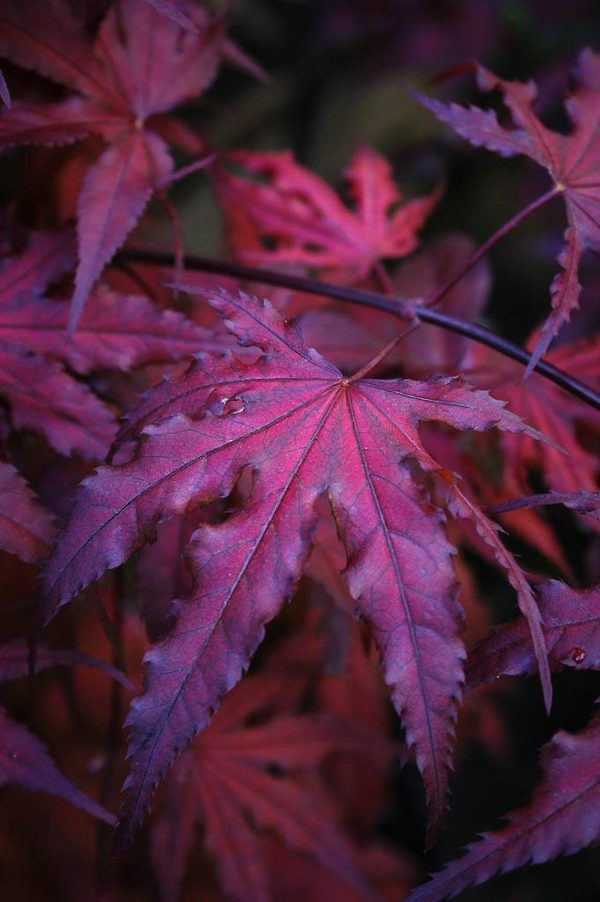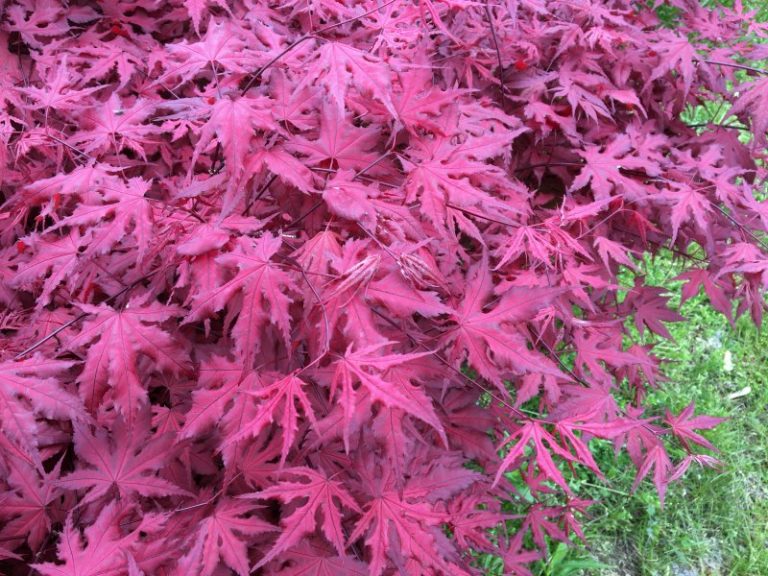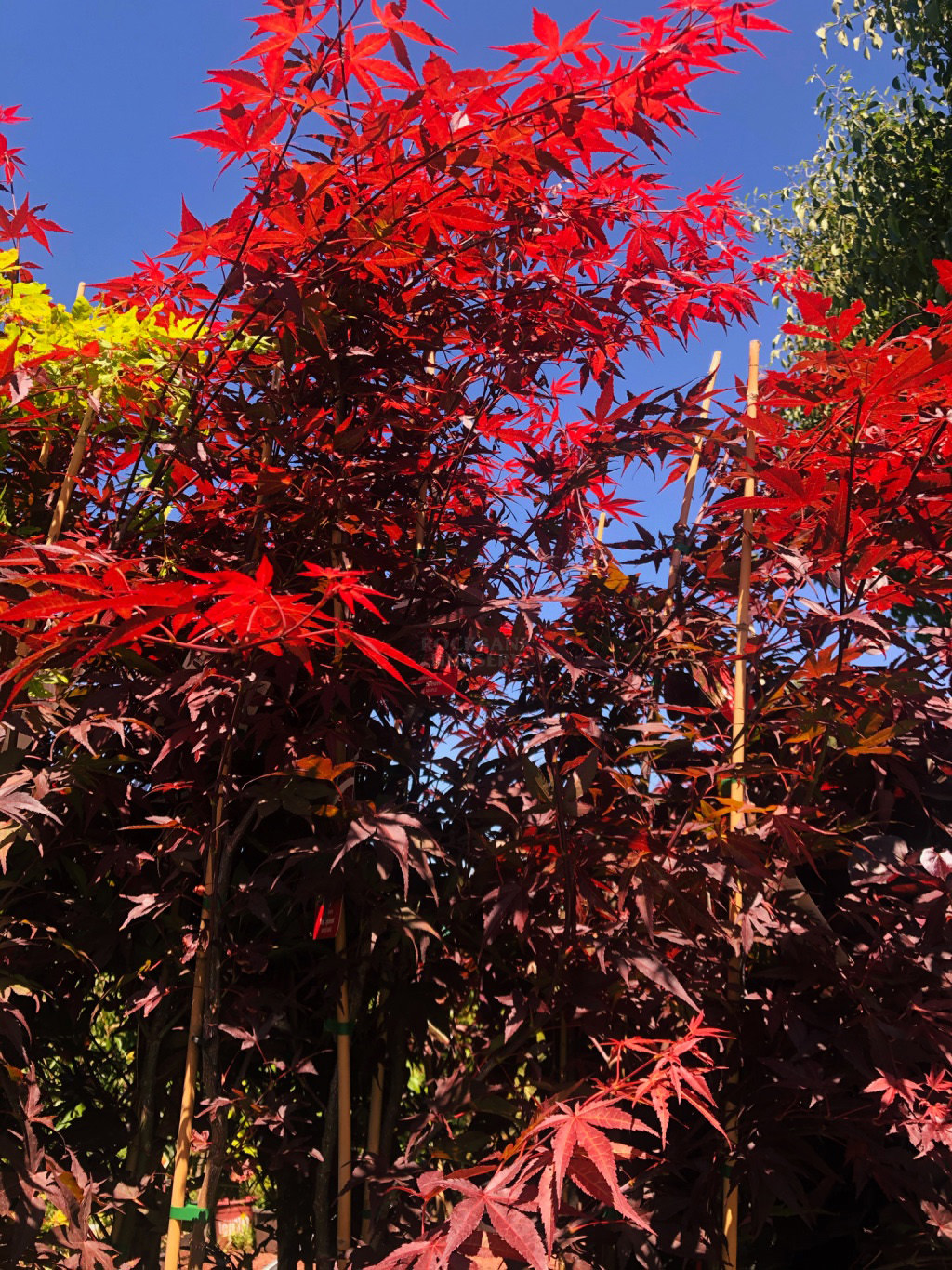Japanese Purple Maple Tree 1520cm Tall, Acer Palmatum Atropurpureum Plant eBay
The Japanese maple tree is renowned for its striking leaves. Japanese maple leaves have five to nine palmate lobes that may come in green or red (or both). In the fall, Japanese maple leaves turn to brilliant shades of red, orange, yellow, or purple, varying in texture with wide lobes, finely dissected lobes, and a lacy, wispy appearance.

Acer palmatum atropurpureum Bloodgood Deep Purple Japanese Maple Garden Plants
A graceful weeping Japanese maple that is one of the widest spreading and one of the fastest growing of the weeping 'laceleaf' types. An excellent cultivar (equal to the better known purple-leafed weeping maples) suitable as a specimen for protected gardens where there is space for it to reach its full potential.
Plant Acer Palmatum Purple Ghost Japanese Maple by Donna Vail in The Vail's Garden Plants Map
The many different kinds of Japanese maples include Acer palmatum, Acer japonicum, and Acer pictum; they are all part of the Sapindaceae (soapberry) family. They are suitable for USDA hardiness zones 5a-8b, though a few can brave zone 4 if planted in protected locations.

Buy Acer palmatum 'Purple Ghost' Japanese Maple Mr Maple │ Buy Japanese Maple Trees
Japanese maples typically prefer cold climate (temperatures up to -10˚C in fact!), but with the right care and conditions will happily grow anywhere in Australia. If you're opting for a planter, Dennis advises to do your research first. "You should choose a smaller cultivar and make sure the pot size is at least twice the size of the root ball.

Acer palmatum atropurpureum Bloodgood Deep Purple Japanese Maple Garden Plants
Remove leaves from the bottom third of the cutting and scrape away the bark along the bottom 4cm to create a wound. Maple cuttings actually root better when wounded. Dip the end of the cutting in a rooting hormone powder, then place one cutting in each pot, burying 2.5cm of the cutting in the mixture you created.

Japanese Purple Ghost Maple Tree Bonsai Flores Acer Palmatum Garden Planting All Best Seeds
Purple Japanese Maple. A beautiful small tree growing to approximately 4 metres in height. Produces dark purple leaves in spring, turning reddish in the summer months before turning scarlet in autumn. Provides great multi-seasonal foliage colour. This tree currently has the following pot sizes in production.

Purple Ghost Japanese Maple For Sale Online The Tree Center
Japanese Maple types include the upright Acer Palmatum and Acer palmatum dissectum, where "Dissectum" signifies deeply cut or divided leaves, giving them an attractive, ferny or feathery appearance. Variegated types and numerous cultivars are also available. Japanese Maple - Green Weeping Form What do the Japanese call Japanese Maples?

Acer 'Purple Japanese Maple' — Rockbank Nursery
Purple Ghost Japanese Maple The Purple Ghost Japanese Maple is a captivating, mid-sized tree famous for its dark purple-red leaves in spring. Come summer, these leaves take on green hues but keep their moody purple undertones. By fall, the tree turns into a stunning spectacle of red foliage.

Acer Palmatum Atropurpureum Purple Japanese Maple ubicaciondepersonas.cdmx.gob.mx
The Japanese Maple (Acer palmatum) is a fabulous addition to any garden and will grow from 0.5m to 25m offering a splendour of colour with its distinctive-shaped leaves. WATCH: The beautiful Japanese garden you need to see in NSW
Japanese Purple Maple Tree, Acer Palmatum Plant in 2L Pot eBay
Growing Japanese maples make excellent specimen or lawn trees. Smaller cultivars are the perfect size for shrub borders and large patio containers. Use upright types as understory trees in woodland gardens. Plant them where you need to add fine texture in the garden. How to Grow a Japanese Maple Tree

Purple Ghost Japanese Maple, Acer palmatum 'Purple Ghost'. Mike's Backyard Nursery
How to grow maples Soil Well-drained. Climate Cool. Aspect Morning sun or part shade. Protect from winds that scorch the leaves. Pruning Prune when tree is beyond being a sapling to develop the shape you want. Do this in summer when sap won't leak from the wounds. Water Keep soil moist, especially during long, hot, dry spells. Food

Acer palmatum 'Atropurpureum' Japanese Maple GardenersDream
Plant Types Trees Acer palmatum 'Atropurpureum' (Japanese Maple) Acer palmatum 'Atropurpureum' (Japanese Maple) Japanese Maple 'Atropurpureum', Acer palmatum 'Blood Leaf' Acer palmatum 'Atropurpureum' is a small deciduous tree of bushy habit with rich purple leaves in the spring, becoming deeper in summer.

Acer 'Purple Japanese Maple' — Rockbank Nursery
Purple Japanese Maples are small deciduous trees with deep purple foliage instead of green, that then becomes a gorgeous red in autumn. Beautiful feature tree. This is a weeping grafted variety. Notify me when available. Acer 'Atropurpureum' Weeping Japanese Maple 13" Pot. $ 209.99.

330mm Purple Japanese Maple Acer palmatum Atropurpureum
Written by: Annette Hird Last Updated: September 27, 2023 Japanese maples have a lovely structure which means they even look attractive in winter after the leaves have dropped. And, they make ideal shade trees over the warmer months. Although not native to Australia, the Japanese maple can be grown in most areas except the tropics or subtropics.

Buy Acer palmatum 'Purple Ghost' Japanese Maple — Mr Maple │ Buy Japanese Maple Trees
Japanese maples are wonderfully seasonal deciduous trees. Spring: buds burst, leaves unfurl and expand. Often, they'll be vibrant colours. Summer: foliage colour settles down to its regular hue. This can still be deep burgundy shades or a wide range of greens and bronzes. There are even variegated forms.

Acer palmatum 'Atropurpureum' (Purple Japanese Maple) 10 Seeds £2.99 Heartwood Seeds
Fertilizer. Japanese maple bonsai require regular fertilizing to encourage strong and consistent new growth. During the spring and summer, feed Japanese maple bonsai every other week with an organic bonsai fertilizer or liquid fertilizer. During the fall, switch to a nitrogen-free fertilizer and cut back on the frequency of feeding.